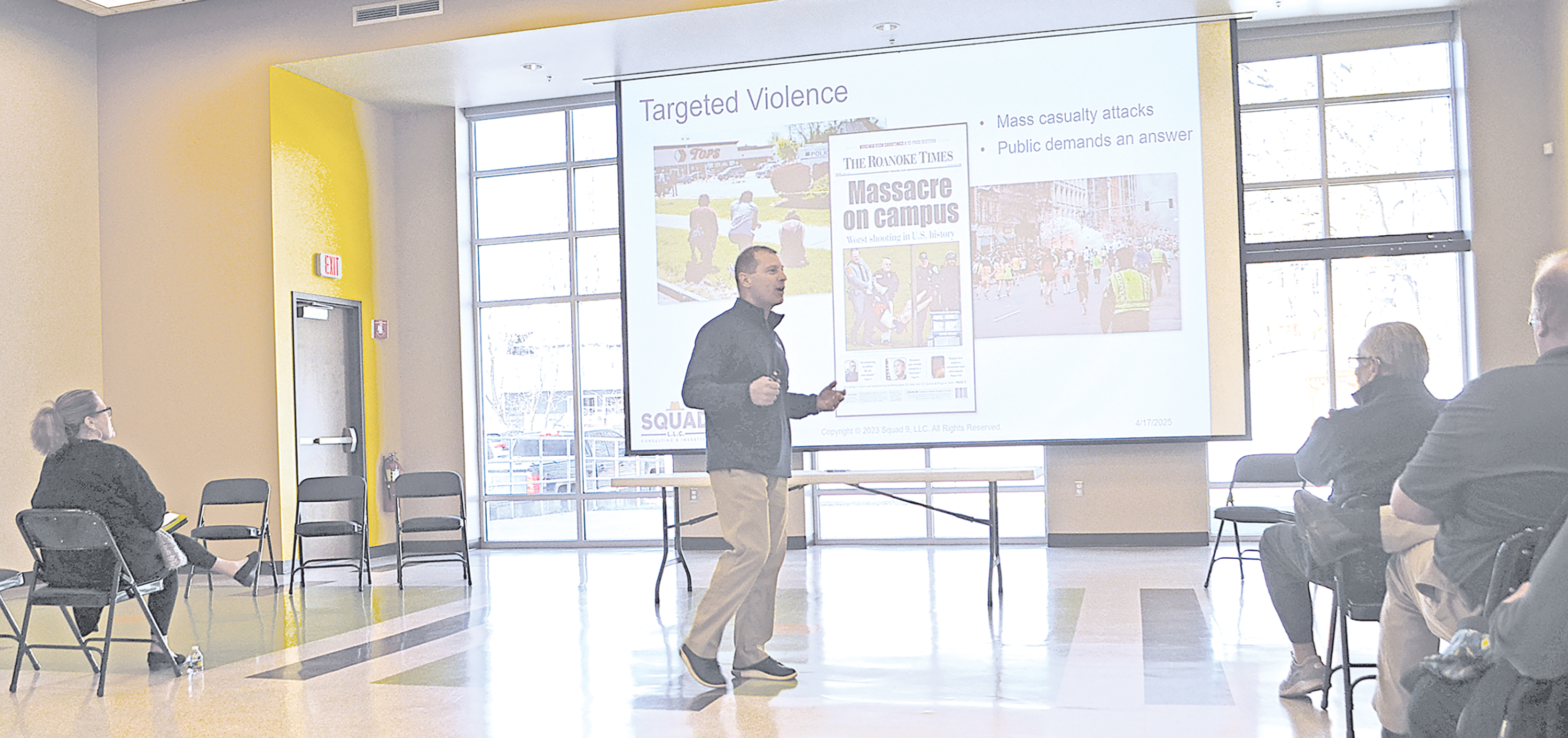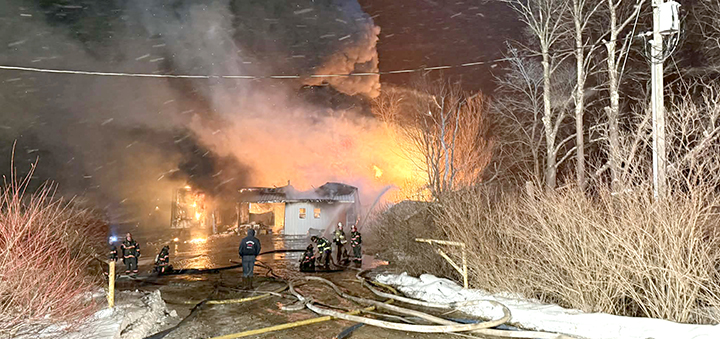ChenTAC: Community safety in focus on anniversary of Chenango County hostage crisis
The Chenango Threat Assessment Committee, (ChenTAC) works to prevent violence by partnering with mental health professionals, police, families and businesses. The group offered a public presentation on April 18, including remarks from retired FBI Special Agent Joseph Testani. (Photo by Tyler Murphy)
CHENANGO COUNTY - On April 25, 1983, Chenango County faced one of its most harrowing moments when Lawrence B. Gladstone and his wife, Christine, armed with shotguns, stormed the Chenango County Office Building and took 17 employees hostage.
The standoff, rooted in a grievance over dozens of seized dogs and animal cruelty charges, lasted eight hours. Shots were fired and fear gripped downtown Norwich. In the end, the hostages were released without serious injuries, but the event became a permanent reminder in the county’s memory of how rapidly a personal grievance can escalate into public violence.
Forty-two years later, that memory remains as community leaders push for better systems to prevent such tragedies. The Chenango Threat Assessment Committee, known as ChenTAC, was formed with the goal of stopping targeted violence before it happens. The group gave a public presentation on April 18 in Norwich.
Catching people on the pathway to violence
Wes Mills, a retired New York State Trooper and leader of ChenTAC, explained that most people experiencing hardship seek help, but some veer dangerously onto a path of violence. That is where ChenTAC steps in.
“Most of us stay on the pathway to help,” said Mills. “The ones that don’t seek help from family members or professionals or friends, they’re veering off onto that pathway of violence. That’s where we need to catch them, as a team and community.”
He outlined a typical escalation: a perceived grievance, often rooted in racial bias, religious animus, family dysfunction, or mental illness, followed by violent ideation. “They decide that violence is the answer,” said Mills. “In my opinion, they don’t stay on ideation very long. Once they’ve reached that, they start researching and planning, ‘where am I going to do it, how am I going to do it.’”
In one example, Mills referenced an attacker who visited a grocery store 13 times before carrying out a shooting. He took notes, asked questions, lingered in the parking lot. “Security even kicked him out a couple of times,” said Mills.
ChenTAC, launched in 2023, brings together law enforcement, school officials, mental health professionals, prosecutors, probation, and local businesses. The team evaluates potential threats and discusses appropriate interventions, from counseling referrals to law enforcement involvement.
Of the 32 cases reviewed by ChenTAC so far, 44 percent involved students in kindergarten through 12th grade. Another 25 percent came from law enforcement, 25 percent from local businesses, and roughly 6 percent from the general public.
All members of the team sign confidentiality agreements and undergo training to maintain privacy. “The most important thing to me is to prevent targeted violence,” said Mills. “We are all on the same page, you’ll learn about the pathway to violence, indicators, and warning signs.”
Why is ChenTAC important?
Retired FBI Special Agent Joseph R. Testani has over 30 years of experience, mostly in counterterrorism and spoke at the presentation.
“I learned this system that Wes and his team deploy to help keep Chenango County safe,” said Testani. “I’m lucky enough to be able to come back to my hometown where I learned my morals and values and give something back.”
Testani shared the chilling story of a man from a small town of 5,000 residents that highlighted the important role ChenTac performs. Friendly and well-liked, he began to unravel in his late 30s, suffering from untreated hearing loss and mental illness. Though his family and officials tried to intervene his paranoia deepened.
“Everyone who came in contact with him did what they should have,” said Testani. “And it didn’t stop the senseless loss of life.”
He began suffering from significant hearing loss, which deteriorated to the point that he believed people were talking about him behind his back. This belief became a fixation. His family noticed the shift and responded appropriately, they expressed concern, attempted an intervention, and urged him to see a doctor. He was eventually diagnosed and fitted with hearing aids. While his family hoped this would help resolve his paranoia, it did not. He continued to believe that people were maligning him, even accusing him of horrific acts of child abuse, claims that had no basis in reality.
He fixated on a local business and its manager, as well as members of the deaf community. His wife and son contacted authorities, explaining that he was deteriorating and expressing dangerous thoughts. Law enforcement engaged him, and a mental health team assessed him as experiencing auditory hallucinations. Though he presented as nonviolent, he was clearly in crisis.
Military personnel who had known him became alarmed after he returned to service. He began making threats about shooting people. Commanding officers took immediate action, contacting law enforcement. Police engaged with him again, leading to his transport to a hospital for psychological evaluation. He was admitted to a treatment facility for several weeks and given medication. He stabilized and was released.
Soon after his release, he attempted to buy a high-capacity firearm, ammunition, and a silencer from a local gun store. The store owner was disturbed by his demeanor and refused the sale. Again, someone in the community did the right thing, but he continued his efforts, visiting other gun shops, seeking to acquire weapons.
Eventually, he physically assaulted an officer at his military barracks. Once again, the military contacted law enforcement. When police visited his home, he refused to engage, yelling through the door that he was fine. Legally, officers could not force entry.
In the following weeks, his appearance deteriorated. He stopped maintaining personal hygiene. His mother found him crying, overwhelmed by the belief that he could not stop the perceived voices speaking against him. One day he left a note taped to his front door addressed to his mother and son. It included bank account information and his phone’s access code. The phone was placed on a table inside.
That evening, he entered a local bowling alley during a youth league event and opened fire. He then drove to the restaurant where he had fixated on the manager and killed him. By the end of the rampage, he had murdered 18 people, aged 14 to 76, and wounded many more.
“Everyone who came in contact with him did what they should have,” said Testani. He explained family members, military personnel, local law enforcement, mental health providers, the gun store owner, each one recognized a problem and acted.
For Testani and the ChenTAC team, the case is not just a tragedy but a rallying cry that underscores why early intervention matters and why communities must remain vigilant.
Making a positive difference
Another ChenTAC member and former police detective, John Fern, described a positive recent case the team had helped, of a man experiencing mental health issues who was acting erratically in public spaces. He had been banned from the YMCA and a local church and was arguing with employees at other businesses in the community. He also falsely believed he had a claim to his family’s business.
Fern reached out to the man’s past acquaintances and discovered a history of court-mandated treatment and medication non-compliance. He also talked to concerned family members and alerted authorities about the man’s background. He eventually agreed to go back into treatment and stabilized. He is in treatment and has a better life.
“It was just a guy acting up at a business,” said Fern. He said by connecting the dots, the team got the full picture, and helped him get back on track.
Commerce Chenango President Sal Testani played a key role in bringing ChenTAC to the area and he emphasized the need for early recognition of behaviors that could escalate to violence.
“The training centers on recognizing the behaviors of those who may be a threat and getting them the help they need before it escalates,” said Testani. “It covers the difference between targeted and spontaneous violence.”
He also emphasized how vital it is to understand that there’s rarely one defining trait shared by all violent individuals. Instead, the path toward violence often begins with a perceived grievance, followed by ideation and preparation.
ChenTAC meetings are held monthly, with core members regularly reviewing cases and strategies.
“If you see something, say something,” he said.








Comments